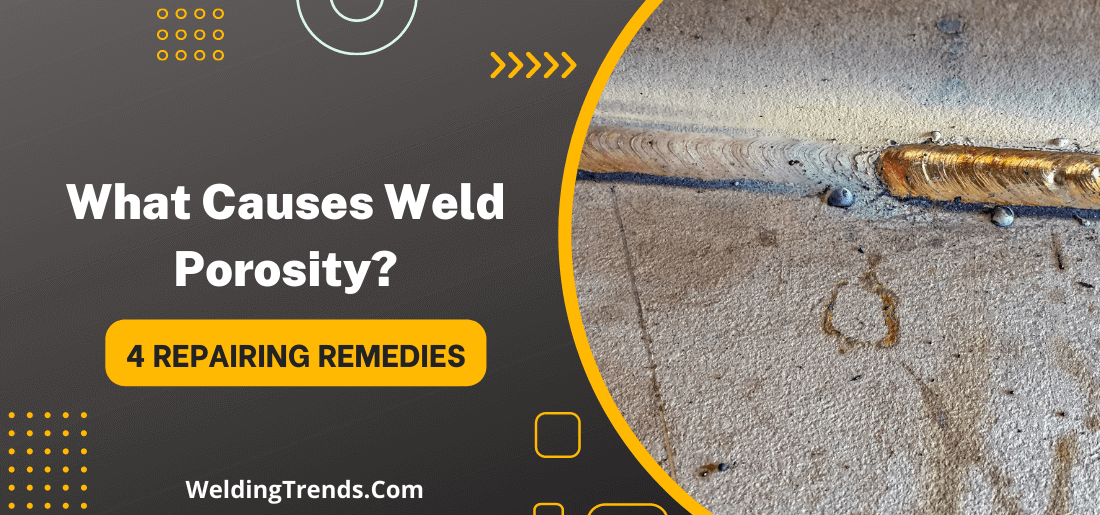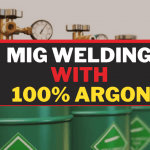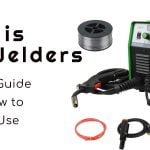When welding, the goal is to create a strong, seamless bond between two pieces of metal. MIG welding is a versatile process that can be used to weld a variety of different metals. MIG welding is a great process for joining materials together.
However, if the wrong settings are used, porosity can be introduced into the weld. This can cause problems with the strength and integrity of the weld.
In this blog post, we will take a look at some of the causes of porosity in MIG welding and how to prevent it. Stay tuned!
What Causes Porosity In MIG Welding?
Porosity is a type of welding defect that can occur in welds. It appears as small holes in the weld and can weaken the bond between two pieces of metal. Porosity can be caused by a variety of factors, including:
1) Incomplete fusion
This occurs when the welding arc does not completely melt the base metal and filler material. This can happen if the welding machine is not set to the correct amperage or if the welding torch is not held close enough to the metal.
2) Poor gas coverage
MIG welding uses a shielding gas to protect the weld from oxygen and other contaminants. If the gas flow is too low, porosity can occur. This can happen if the gas regulator is not set correctly, or if there are leaks in the gas hose.
3) Gas entrapment
Another cause of porosity is gas entrapment. This occurs when gas bubbles become trapped in the weld pool. This can happen if the welding torch is not held at the correct angle or if there is too much shielding gas.
4) Dirt and contaminants
Porosity can also be caused by contamination of the base metal or filler material. Dirt, rust, paint, and other contaminants can also cause porosity. This can happen if the metal is not clean before welding, or if there is rust or paint on the surface. These contaminants can prevent the weld from properly bonding to the metal.
5) Inadequate shielding gas
Another cause of porosity is inadequate shielding gas. This can happen if the wrong gas is used for the welding process or if the gas flow is not set correctly.
How can you prevent porosity from occurring during mIG welding process?
There are a few things that you can do to prevent porosity from occurring during the MIG welding process:
- Use the correct settings: Make sure that you are using the correct settings on your welding machine. The amperage and voltage should be set according to the manufacturer’s instructions.
- Use the correct gas: Be sure to use the correct gas for your welding process. Argon is typically used for MIG welding.
- Gas flow: Set the gas flow rate according to the manufacturer’s instructions. Too much or too little gas can cause porosity.
- Keep the torch at the correct angle: Be sure to hold the torch at the correct angle to avoid gas entrapment. The torch should be held at a 10 to 15-degree angle from the surface of the metal.
- Use clean metal: Be sure to use clean, uncontaminated metal for your weld. Any dirt, rust, or paint on the surface can cause porosity.
- Weld in a well-ventilated area: Weld in a well-ventilated area to avoid gas entrapment. Shielding gas can become trapped in enclosed spaces.
Porosity can be prevented by following these tips. By using the correct settings and welding in a well-ventilated area, you can avoid this problem.
common remedies for repairing Porosity welds
There are a few common remedies for repairing welds that have been affected by porosity:
- Re-welding: One common remedy is to re-weld the affected area. This can be done by welding over the affected area with higher amperage.
- Porosity plugs: Another common remedy is to use porosity plugs. These are small metal discs that are placed over the holes in the weld. Porosity plugs can be bought at most welding supply stores.
- Grinding: Another option is to grind out the affected area and re-weld it. This can be done with a hand-held grinder or an angle grinder.
- Welding wire: Another remedy is to use welding wire. This is a thin wire that is used to fill in the holes in the weld. Welding wire can be bought at most welding supply stores.
Porosity can be repaired by using one of these common remedies. By re-welding the area or using porosity plugs, you can fix the problem.
FAQs – cause of porosity in MIG welding
Can porosity be eliminated from mIG welding altogether?
The answer to this question is unfortunately No. Porosity is an inherent issue in MIG welding and can be caused by a variety of factors.
However, there are ways to minimize porosity, and some welders can produce porosity-free welds more often than others. The best way to avoid porosity is to have a good understanding of the causes and take steps to prevent them.
Why do my MIG welds have bubbles?
There are a few reasons why your MIG welds might have bubbles:
- Porosity: This is caused by gas pockets in the weld. It can be caused by insufficient shielding gas, leaks in the gas hose, or contamination of the metal.
- Inadequate penetration: This can be caused by welding at too high of a speed, using too much wire, or having the torch held at the wrong angle.
- Poor fit-up: This can be caused by incorrect joint preparation or warping of the metal.
If your welds have bubbles, you can try increasing the gas flow, welding at a slower speed, or using less wire. You can also try grinding down the weld to increase penetration. If you are still having trouble, you can consult welding professionally for help.
Can you weld over porosity?
Yes, you can weld over porosity. This is often done to repair welding that has been affected by porosity. To do this, weld over the affected area with higher amperage. This will fill in the holes and give you a stronger weld.
What should gas flow be for MIG welding?
The gas flow rate should be between 15 and 20 cubic feet per hour. This will give you adequate shielding for the weld and provide the best results for your MIG welding.
Why do MIG welding spit and sputter?
There are a 3 reasons why your MIG welding might spit and sputter:
- Incorrect gas mixture: This can be caused by using the wrong gas for your welding process.
- Incorrect gas flow: This can be caused by having the gas flow rate set too high or too low.
- Dirty welding gun: This can be caused by dirt or debris in the welding gun. Be sure to clean the gun before welding.
If your MIG welding is spitting and sputtering, you can try adjusting the gas mixture, gas flow rate, or cleaning the welding gun.
Final Words
Porosity can cause several problems in MIG welds, including reduced strength and decreased resistance to corrosion. Fortunately, there are several ways to reduce the likelihood of porosity forming in your welds.
By understanding the causes of porosity and using the right welding techniques, you can create beautiful, strong MIG welds that will last for years.
Knowing the causes and how to prevent porosity will help you produce better welds. If you’re having problems with porosity in your welds, be sure to try some of these tips to correct the issue.




